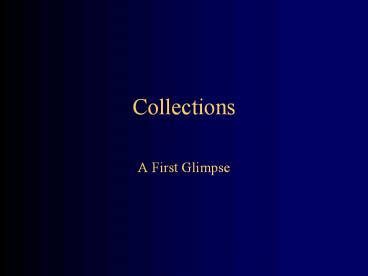Collections - PowerPoint PPT Presentation
Title:
Collections
Description:
Vectors have been redefined to implement Collection ... Arrays do not implement the Collection interfaces. 3. Types of Collection ... – PowerPoint PPT presentation
Number of Views:35
Avg rating:3.0/5.0
Title: Collections
1
Collections
- A First Glimpse
2
Collections
- A collection is a structured group of objects
- An array is a kind of collection
- A Vector is a kind of collection
- A linked list is a kind of collection
- Java 1.2 introduced the Collections Framework and
provided many great implementations - Vectors have been redefined to implement
Collection - Trees, linked lists, stacks, hash tables, and
other classes are implementations of Collection - Arrays do not implement the Collection interfaces
3
Types of Collection
- Java supplies several types of Collection
- Set cannot contain duplicate elements, order is
not important - SortedSet like a Set, but order is important
- List may contain duplicate elements, order is
important - Java also supplies some collection-like things
- Map a dictionary that associates keys with
values, order is not important - SortedMap like a Map, but order is important
4
Collections are ADTs
- Im not going to cover Collections just yet, but
I want to use them as an example - Collections are one of the best-designed parts of
Java, because - They are elegant they combine maximum power with
maximum simplicity - They are uniform when you know how to use one,
you almost know how to use them all - You can easily convert from one to another
5
Uniformity through interfaces
- Much of the elegance of the Collections Framework
arises from the intelligent use of interfaces - For example, the Collection interface specifies
(among many other operations) - boolean add(Object o)
- boolean isEmpty()
- boolean remove()
- int size()
- Object toArray()
- Iterator iterator()
6
Vectors
- The class Vector has been retrofitted to
implement the Collection interface - Vector supplies add(Object) and iterator()
methods (among others) - Lets look at creating a Vector and iterating
through the elements
7
The Iterator interface
- interface iterator // java.lang.util
- boolean hasNext()
- // Returns true if the iteration has more
// elements. - Object next()
- // Returns the next element in the //
interation. - void remove()
- // Removes from the underlying collection
// the last element returned by the //
iterator (optional operation).
8
Using a Vector
- Collection numerals new Vector() numerals
.add("one") numerals .add("two") numerals
.add("three") - Iterator iter numerals.iterator() while
(iter.hasNext()) System.out.println(iter.n
ext()) - Results one two three
9
Using a TreeSet
- Collection numerals new TreeSet() numerals
.add("one") numerals .add("two") numerals
.add("three") - Iterator iter numerals.iterator() while
(iter.hasNext()) System.out.println(iter.n
ext()) - Results one three two
10
Conversions
- Vector v new Vector(numerals)
- TreeSet ts new TreeSet(v)
11
Back to arrays
- Arrays are not part of the new Collections
Framework, but they havent been ignored - Java 1.2 introduced the new Arrays class, with
some useful operations, for example - static void sort(Object a)
- static int binarySearch(Object a, Object key)
- static boolean equals(Object a, Object a2)
- static void fill(Object a, Object val)
- static void fill(Object a, Object val,
int from, int to) - static List asList(Object a)
12
What to remember
- We havent really begun to study the Collections
framework yet, but - You should learn to use the Iterator interface
- You should examine and learn more about the
Arrays package
13
The End

